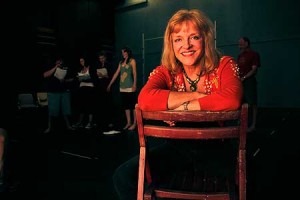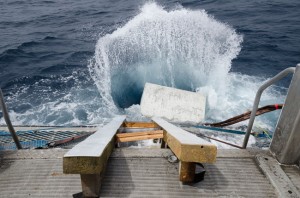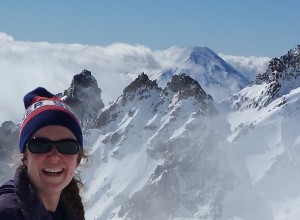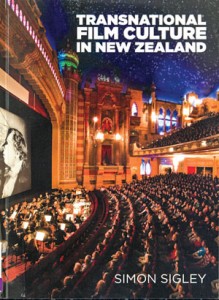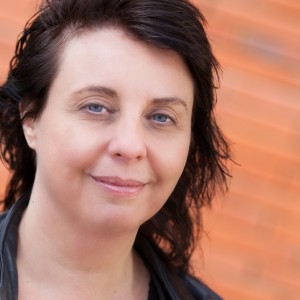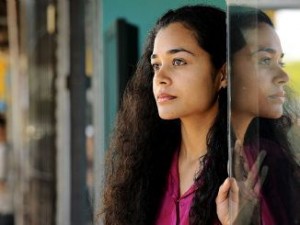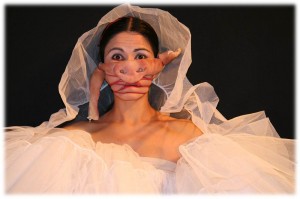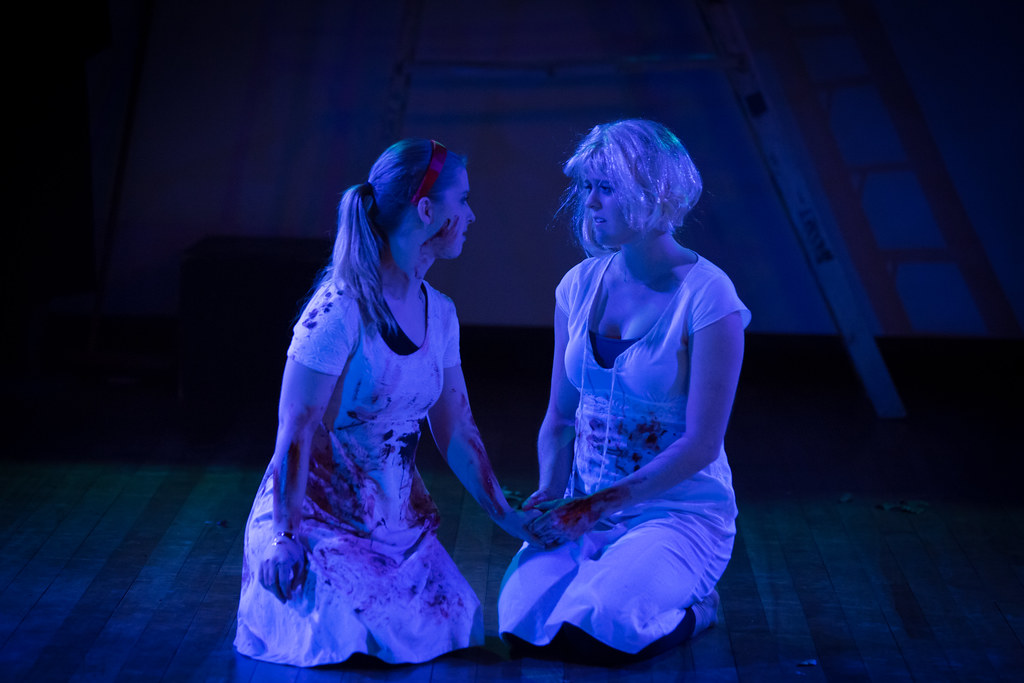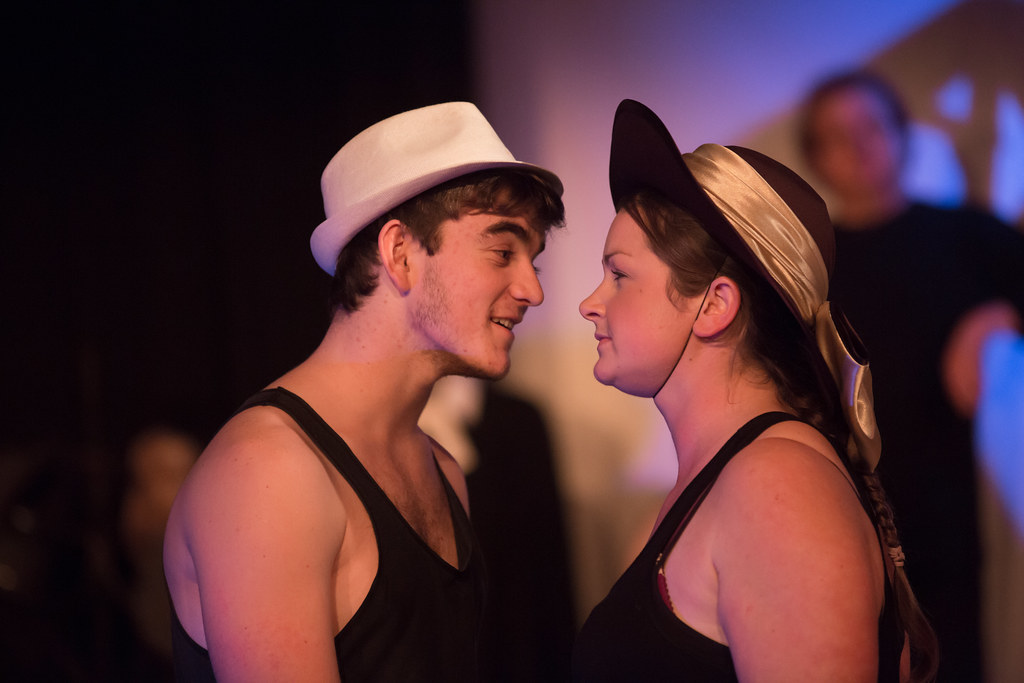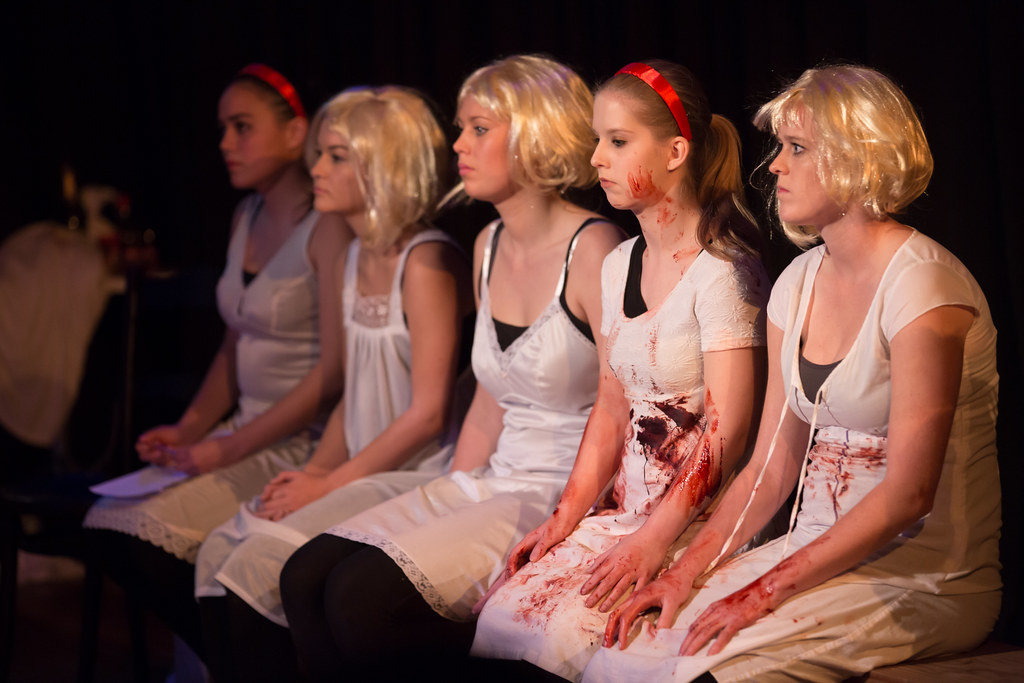Good news. Angie Farrow has won ‘Best Drama Script’ for her new play ‘Leo Rising’ at the Auckland Short and Sweet Festival 2014. Congratulations to Angie.
Category Archives: News
Essay key component of Walters Prize shortlisted artwork
A creative essay by School of English & Media Studies senior lecturer Dr Ingrid Horrocks is currently featuring as part of the Walters Prize exhibition at the Auckland Art Gallery.
The essay forms a key part of Maddie Leach’s collaborative conceptual art project ‘if you find the good oil let us know’, which is a finalist in this year’s Walters Prize, New Zealand’s premier contemporary art award. All four finalists are on display at Auckland Art Gallery Toi o Tamaki until 12 October 2014.
The $50,000 Walters Prize, named after the late New Zealand artist Gordon Walters, is awarded for an outstanding work of contemporary New Zealand art produced and exhibited during the past two years. The prize aims to make contemporary art a more widely recognised and debated feature of our cultural life.
Dr Horrocks’ work of critical-creative prose is the closing piece in the publication, ‘if you find the good oil let us know’, which is the culmination of Maddie Leach’s 2012 Govett-Brewster Aotearoa New Zealand Artist in Residence project of the same name. The project as a whole unfolds an imaginative narrative of whales, cement, art works, scientists, seafarers, migrations, and oil companies via a community of letter-writers and readers.
Dr Horrocks’s contribution works both as part of the artwork, and as the single critical response to the work as a whole. It also involves a recorded performance of her work, which serves as the audio narrative of the project in its next incarnation online in association with the Walters Prize exhibition at the Auckland Art Gallery.
Maddie Leach is a senior lecturer and postgraduate coordinator for fine arts, in Massey University’s Whiti o Rehua – The School of Art at Wellington.
Link: http://maddieleach.net http://www.aucklandartgallery.com/media/6032904/twp2014_catalogue.pdf
Ski trip yields important safety communication data
Staff and students from the School of English & Media Studies enjoyed the stunning view from their ‘office’ yesterday as they undertook fieldwork on Mt Ruapehu.
Associate Professor Elspeth Tilley and Bachelor of Communication students Oscar Mein and Eden Cowley helped collect data about people’s behaviour during a lahar warning test run by GNS Science and the Department of Conservation.
The fieldwork is part of a research collaboration investigating ways to optimise safety communication at the skifields that includes English & Media Studies staff and students and Massey’s Joint Centre for Disaster Research. Some of the issues for mountain users include lahar warnings, avalanche risk and general mountain safety.
“The agencies in the front line of mountain safety such as GNS Science and Department of Conservation have been working together for many years and have very good data about the risks and about public behaviour,” Dr Tilley said. “As we saw at the lahar warning test yesterday, though, it’s still the case that not every mountain user knows what to do. When the siren sounds, people need to immediately get out of the valley floor and climb to higher ground – some do, others do only when other public-minded bystanders call out to them repeatedly or a ski patroller moves them, and some remain where they are, hypothetically in the path of a massive fast-flowing gush of boiling water, sediment and boulders.”
“The next step in the research is to identify the missing link between someone knowing about a risk and responding appropriately. We also need to know more about those mountain users who genuinely aren’t aware of the risks or how to mitigate them.”
“That’s where communication staff and students can make a big contribution. We’ll be bringing a humanistic or people-centred approach to understanding the communication processes. Some of our students will have the opportunity to extend the research with funded postgraduate study, living on the mountain next ski season and conducting ethnographic and focus group research to identify communication patterns and norms, and make recommendations about how, when and where to create the most effective safety messaging.”
Dr Tilley said understanding ‘mountain culture’ could be the key to unlocking the right communication tactics. “Groups of people who share an interest and affinity, such as for family ski trips, snowboarding weekends or climbing expeditions, create and define their own group culture. They establish behaviours, thoughts, and norms that define their identity as a member of the group.
“Effective communication occurs when the identity that a message assigns to a person matches the identity she or he wants to claim in a situation – so to target a particular group, you have to have very good research about how they construct their identity as a group and what notions of identity are appealing.”
“Creativity also has a big role to play. As well as documenting the culture and its communication, our students will need to make innovative and creative recommendations about practical ways to communicate that produce a positive sense of identity that includes being knowledgeable and proactive about safety.”
Yesterday’s lahar warning test research project activity was recorded by Alison Ballance, producer and presenter of Radio New Zealand’s weekly science and environment programme Our Changing World. Alison’s story on the project will be aired on RNZ in the next week: go to http://www.radionz.co.nz/national/programmes/ourchangingworld/20140911 for the story and the podcast.
Links to more information:
- Ruapehu Lahar information from DOC: http://www.doc.govt.nz/documents/about-doc/concessions-and-permits/conservation-revealed/lahars-from-mt-ruapehu-lowres.pdf
- Footage of the 2007 Mt Ruapehu lahar: https://www.youtube.com/watch?v=5x5tZAHEoRU
- TVNZ 4-minute video about Ruapehu lahars: http://tvnz.co.nz/meet-the-locals/2007-episode-81-video-1883399
New creative activism paper launching 2015
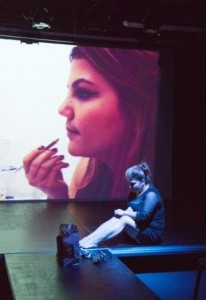 Massey University’s School of English & Media Studies will lead the way in Aotearoa/New Zealand arts education by launching a new paper in creative activism in 2015.
Massey University’s School of English & Media Studies will lead the way in Aotearoa/New Zealand arts education by launching a new paper in creative activism in 2015.
Launching simultaneously at Wellington and Auckland campuses in first semester 2015, 139.333 Creativity in the Community will immerse teams of students in the art and science of creative communication for social change, with guidance from experienced Expressive Arts educators. Students will be able to make a film or documentary, stage a collaborative community theatre event, use creative writing, or combine all of these, to work with a community group on a real issue.
Wellington course coordinator Associate Professor Elspeth Tilley said “communication activism pedagogy is an emerging trend internationally. It involves teaching students to apply their creative communication knowledge and skills to work with community partners to promote social justice.”
“We are seeing increasing application by social justice groups in Aotearoa of the power of the arts to drive change – for example Women’s Refuge is working on a giant statue of Kate Sheppard made up of the voices of people who want to stop domestic violence, and Greenpeace has been staging performance art all over the country with a lifesize polar bear. Not to mention the amazing work that theatre practitioners, such as the group Te Rakau Hua o Te Wao Tapu Trust to name just one, have been doing for a long time because of the recognition of the power of theatre to change lives.”
The Creativity in the Community course will equip students to plan, implement and evaluate these kinds of applied arts projects, giving them hands on experience in delivering creative activism but also requiring them to understand the ethical and managerial dimensions.
“Our Expressive Arts students already have a strong foundation in devising projects that use creative writing, theatre and multimedia by the time they reach third-year (see for example at left a student multimedia/theatre performance addressing issues of identity and binge drinking, from Wellington Creative Processes students 2014). This paper enables them to capstone that training by taking it to the next level, working with a community partner.”
Dr Tilley said there was a strong research and scholarship base behind creative activism that students will connect with in ‘Creativity in the Community’ to understand how to make their arts interventions effective and compelling.
“Internationally, students have worked on issues such as gender inequality and violence, ethnic and racial prejudice and discrimination, and health disparities and issues affecting those who live in poverty. Our students will research their communities and team up with local NGOs to choose projects that respond to genuine need. We know that this benefits the students as well as the communities, as service learning has been proven to develop skills in teamwork, project management, risk assessment, communication, professionalism and a host of other competencies that will ensure our students hit the ground running when they enter the workforce. A big plus of creative activism pedagogy is that it also develops students as engaged citizens who feel empowered to use their voice effectively to create a better world.”
Dr Tilley will coordinate Creativity in the Community at Wellington, while at Albany campus it will be led by Dr Rand Hazou, a specialist in applied and documentary theatre who has international research links with social justice theatre projects, as well as strong connections with theatre-for-social change groups in the Auckland region.
“We are really looking forward to launching this project and seeing the students’ learning come to life in real social change,” Dr Tilley said.
Links:
139.333 Paper Information for 2015: http://www.massey.ac.nz//massey/learning/programme-course-paper/paper.cfm?paper_code=139333
Bring back Kate campaign: http://www.3news.co.nz/Kate-Sheppard-statue-nears-completion/tabid/423/articleID/354173/Default.aspx
Theatre as a tool to transform: http://artsaccess.org.nz/theatre-as-a-tool-to-transform
Cinephile: Simon Sigley
Transnational Film Culture in New Zealand is a niche publication, written because its author loves film. Film was the most important medium of the 20th century, Simon Sigley says, “a protean cultural phenomenon with huge industrial and aesthetic ramifications”, and he is fascinated by its changing cultural status in his native New Zealand, the more so because for around a decade he lived in a country where film has always been given its intellectual due: France. A film viewed in the cinema, the environment for which it was crafted – is special. Nothing, says Sigley, compares with that visceral, embodied experience of cinema, that moment when lights dim, the chatter stops, the sound swells and the movie begins.
See more at: http://definingnz.com/cinephile/#sthash.JavN9hOg.dpuf
Naomi Richards accepted for PhD in Creative Writing, Lancaster University
Naomi Richards, former creative writing student at Massey, has been accepted for her PhD in Creative Writing at Lancaster University. “I really enjoyed studying creative writing at Massey University. Now I’m very excited about starting a PhD in Creative Writing at Lancaster University, in England in October 2014.”
June 2014: New Zealand stage director, Dione Joseph, heads to NYC for the Lincoln Centre’s directorslab!
Seven years ago budding theatre director and third year Massey University student Dione Joseph left New Zealand to go on a six month exchange to study theatre and film at one (if not the most) iconic college destinations in the world, University of California, Los Angeles. It was an experience that would change this young kiwi’s path forever.
This year, after directing over thirty productions since that exchange she returns to the USA to represent New Zealand at one of the most prestigious centres for performance: as an invited participant in the 2014 Lincoln Centre’s DirectorsLab.
Having directed continuously since her early 20’s (both at home and internationally) this invitation comes at an opportune moment in Ms. Joseph’s career.
“I didn’t plan to be a theatre director,” says Ms. Joseph, “In fact I went to Massey, Palmerston North to become a vet. Unfortunately, I soon found that my love for James Herriot’s writing didn’t quite translate to the dissection lab; and after a few incidents with half-frozen rats and the potential of carving up puppies – I decided a career change might be in order.”
Her love for literature made the decision to switch to the arts obvious. But it was in the drama department that she found her real passion. Under the tutelage of Dr. Angie Farrow she directed her first production in 2006, “The Land of Heart’s Desire”, an obscure Irish play by W.B Yeats about love, faeries, and of course being whisked away on your wedding night.
“It was a bizarre choice for a first attempt as a young director and I am so grateful to my cast for trusting me to direct such a work,” says Ms. Joseph, “At the time I had been studying post colonial literature and was increasingly drawn to the stories and voices from Ireland, South Africa and the Caribbean. They offered a perspective of the world that I felt increasingly connected to, an awareness of New Zealand’s past and history within multiple contexts; a changing landscape where I felt that my voice and my story has a place in our country’s unique and complex cultural matrix.”
Since then Ms. Joseph has directed a range of diverse productions, including being invited to direct Neil Simon’s Fools at UCLA during her exchange; a work in Fuyang, China with local women; numerous productions in Melbourne, Australia and also an opportunity to be Assistant Director to Scott Rankin from Big hART on the company’s latest production of Hipbone Sticking Out.
She will be the only New Zealander amongst fifty of the world’s top international directors who will be spending three weeks at this year’s directorslab. “I applied two years ago to the lab but I didn’t get in, “says Ms. Joseph. This year not only is the theme of the lab focused on audience (ideal for my community based work) but I’ve also been able to clarify a lot of the reasons as to how and why I want to create large scale community based performances.” Ms. Joseph who graduated as a Massey Scholar with a BA in English has also received a first class honours in theatre studies from the University of Melbourne and an Artist scholarship to complete her MA in Community and Cultural Development from the VCA (Victorian College of the Arts). In addition, she is the recipient of numerous artistic and academic accolades and is honoured to be representing New Zealand in New York. “It’s not just about me, it’s about our whanua, the communities I work with, the creatives who trust me, the audiences who come to these productions with the understanding that story is medicine, and that theatre is a space to grow, engage, share and be transformed.” She adds, “I strongly believe a diversity of voices and perspectives from Aotearoa need to be heard and that people across the globe are witness to the fact that New Zealanders are individuals who work tirelessly to fulfil a vision that will serve not themselves, but their community; that is engineered not for self advancement but based upon the unswerving commitment to our people and our stories. That is certainly one of the most rewarding reasons to be in attendance at this year’s lab: to participate in however small a way, to ensure that our distinct voice is heard in an international context.”

Full house for compelling performance
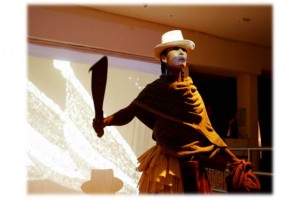 The audience for Violeta Luna filled the Massey University Wellington Museum Building theatrette to capacity on Friday for her mesmerising performance of NK603.
The audience for Violeta Luna filled the Massey University Wellington Museum Building theatrette to capacity on Friday for her mesmerising performance of NK603.
Members of the public joined Australasian Drama Studies Association conference delegates to watch open-mouthed as Luna transformed in front of their eyes from a traditionally-dressed Aztec woman planting seeds by hand to a blood-spitting, tape-bound embodiment of the toxicity she sees wrought on her people and the environment by monocropping and genetic modification.
Fixing the audience with her stare and moving among the seating to get up close and personal with attendees, Luna issued a wordless yet wholly eloquent challenge to all present. Using visual images, music and physical theatre, despite not having a single word of dialogue, she effectively called into question the environmental, social and political consequences of the globalisation of agriculture. Her show charted a trajectory from indigenous Mexican traditions of small-cropping and organic companion planting to foreign-owned mass crops, automation, wholesale use of pesticides, fungicides, and the alteration of seeds that renders them non-renewable.
“It is important for me to work with audience interactivity, with direct contact, where the public becomes co-creator of the work,” Luna said. “The experience of immediacy, of the shared instant and the accident, gains new meaning in these actions.” Audience members at NK603 were in the firing line as corn was thrown, and some were handed bright blue balls of pastry representing over-processed, artificially coloured and genetically altered foods.
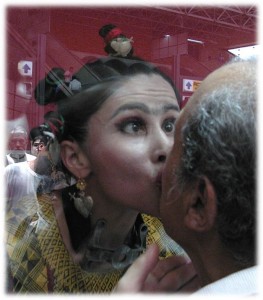
The following day Luna presented an equally powerful keynote address to the ADSA conference, charting the territory of her many theatre projects, both solo and collaborative, that address issues of social justice. “My work is the result of a dialogue between the language of theatre and the language of performance art,” she told delegates. “I create a multi-dimensional space where different elements (music, dance, ritual, behaviors, etc.) converge to create new narratives and alternative realities.”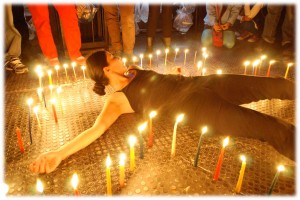
Luna spoke about her collaborative works with Guillermo Gomez Peña, Secos & Mojados, and Pocha Nostra, which have included a live acupuncture work where audience members placed needles with flags into Luna’s body to signify colonisation “In performance art, the artist’s body is considered as the main platform for the work. The body is like a conceptual map where the artist creates her personal cartographies, a metaphorical space- a body that is in itself subject and object- and the signified and signifier of the creative work.”
Her repertoire has included a number of works collaborating with community groups, particularly immigrant women dealing with culture shock and marginalisation, who find rituals of healing become available to them through being able to participate in performative re-creations of their experiences. “In performance art, the female body transforms into a ‘liberated zone’ for creativity, and also for the reinvention of gender within inclusive contexts, where ‘the feminine’ is not generalized through pre-fabricated concepts. Instead, it is particularised, presented, through a specific, self determined woman, with her differences, her own biography.”
Luna was brought to New Zealand by the Expressive Arts program in the Massey University School of English & Media Studies, as part of Massey’s co-hosting (with Victoria University of Wellington) of the ADSA 2014 conference.
Hard-hitting or controversial work welcome in Poetry NZ
![[Jack+Ross+(2002).jpg]](http://2.bp.blogspot.com/_dSZQ_FbAxSA/Rxbbz8pGaXI/AAAAAAAAAGY/6aFTQknvTl4/s400/Jack%2BRoss%2B(2002).jpg) Jack Ross, new editor of Poetry NZ, will be featured on Radio NZ National this Sunday. Jack is being interviewed by Justin Gregory about his plans for Poetry NZ on “Standing Room Only”, this Sunday (8/6). The programme starts at 12:40 pm. Jack said he will be talking with Justin about his plans to keep the journal at the cutting edge and encourage ground-breaking, even controversial, work. “As the new managing editor of Poetry NZ, I’d like to keep up a sense of excitement in the magazine. My predecessor, Alistair Paterson, was careful to maintain a youth-focus — both with the poets he featured and the work he included. I’d like to be as open as he was to new styles and new poetic approaches. Nor do I have any problem at all with including hard-hitting or controversial work. “Louis Johnson, who founded the New Zealand Poetry Yearbook in the 1950s, refused to withdraw some poems which the funding agencies objected to in the early sixties, and instead paid for the last volume of his yearbook himself! It’s that kind of courage I’d like to emulate. I don’t want there to be anything predictable about what people can expect when they open a copy of Poetry NZ. As the poet Alan Brunton once put it: “Keep the surprise alive!’ “The School of English and Media Studies at Massey University has been generous with a publishing subvention, and I hope that in future this journal can fold into our programme in numerous ways: perhaps principally by providing some of our graduate students with an internship in the world of practical magazine publishing.” Jack himself has published four poetry collections: City of Strange Brunettes (1998), Chantal’s Book (2002), To Terezín (2007) and Celanie (2012).
Jack Ross, new editor of Poetry NZ, will be featured on Radio NZ National this Sunday. Jack is being interviewed by Justin Gregory about his plans for Poetry NZ on “Standing Room Only”, this Sunday (8/6). The programme starts at 12:40 pm. Jack said he will be talking with Justin about his plans to keep the journal at the cutting edge and encourage ground-breaking, even controversial, work. “As the new managing editor of Poetry NZ, I’d like to keep up a sense of excitement in the magazine. My predecessor, Alistair Paterson, was careful to maintain a youth-focus — both with the poets he featured and the work he included. I’d like to be as open as he was to new styles and new poetic approaches. Nor do I have any problem at all with including hard-hitting or controversial work. “Louis Johnson, who founded the New Zealand Poetry Yearbook in the 1950s, refused to withdraw some poems which the funding agencies objected to in the early sixties, and instead paid for the last volume of his yearbook himself! It’s that kind of courage I’d like to emulate. I don’t want there to be anything predictable about what people can expect when they open a copy of Poetry NZ. As the poet Alan Brunton once put it: “Keep the surprise alive!’ “The School of English and Media Studies at Massey University has been generous with a publishing subvention, and I hope that in future this journal can fold into our programme in numerous ways: perhaps principally by providing some of our graduate students with an internship in the world of practical magazine publishing.” Jack himself has published four poetry collections: City of Strange Brunettes (1998), Chantal’s Book (2002), To Terezín (2007) and Celanie (2012).
The interview can be found at:
http://www.radionz.co.nz/national/programmes/standing-room-only/audio/2598858/poetry-new-zealand
Daughters of Heaven: Drama in Performance 139.104
Based on the notorious 1954 Parker-Hulme murder, Michelanne Forster’s Daughters of Heaven tells the tale of two teenage girls who conspire to murder one of their own mothers. The play explores the breakdown of one moral universe and its replacement with another that is potent, powerful and, ultimately, tragic. Directed by Rachel Lenart, students of 139.104 Drama in Performance performed adaptation of Daughters of Heaven which featured techniques associated with the German playwright and theorist Bertold Brecht at the Black Sheep Theatre on Massey’s Palmerston North Campus on the 28th and 29th of May 2014.
